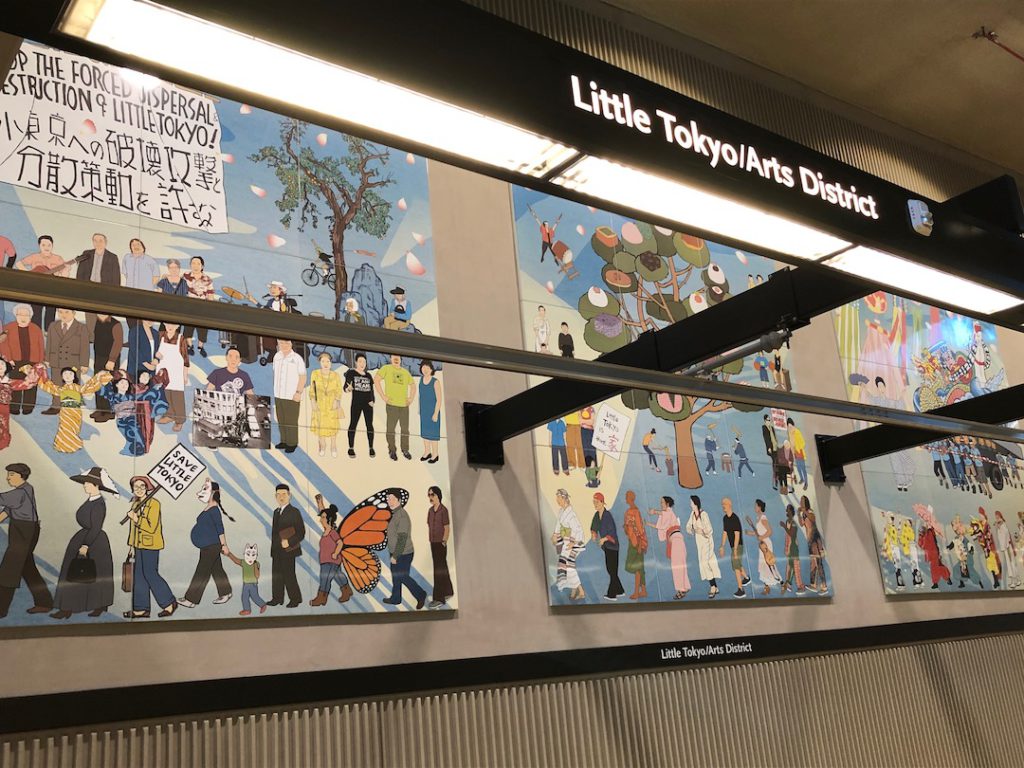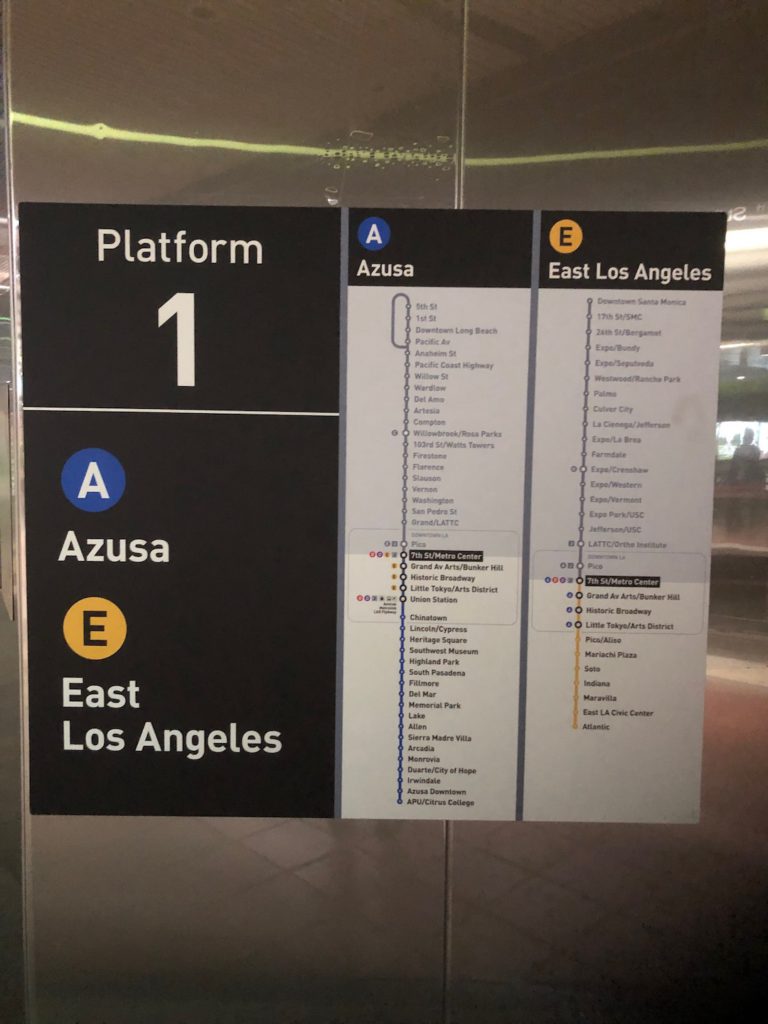
I chose the most inconvenient entrance to the 7th Street/Metro Center Station. It’s the one on the corner of 7th and Figueroa, the first one you’ll notice if you’re walking from Target, which I was, and the one that might be most convenient if you’re trying to take the Metro to Long Beach or Santa Monica, which I was not. I was going to Chinatown, which meant that I needed the A towards Azusa. This also meant that I would head down to the A/E platform, then upstairs to cross the tracks, then down again to board the Azusa train that might have been pulling up to the stop right as I hastened my pace. I darted up and down steps despite hauling two totes— one loaded with groceries, the other with a wet bathing suit and towel— and a purse.
At this point, I’ve taken the A to 7th Street enough times to know where each entrance and exit leads, but I still took the wrong one. I did this intentionally partially because I didn’t feel like walking by the massive, fresh pile of crap atop a ventilation grate, which I saw earlier and which I could only imagine would be smeared all over the sidewalk by now. If I can avoid hopping like an ‘80s video game character over sidewalk poop, I will. I also didn’t feel like using the entrance across from Walgreen’s, the one that permanently smells like a port-a-potty on the third day of Coachella, because we were more than a week into a heatwave and I was over how intense the city smells when the temperature hits 90 degrees.
I know that’s not the most appealing description of downtown Los Angeles, but I’m not an influencer. I’m not writing this to stoke envy or FOMO and persuade you to buy your way into my life. I’m writing it because Los Angeles is my hometown and downtown has been my stomping grounds for over a decade. I love this place. But, the reality is that the second largest city in the U.S. only has 14 permanent public bathrooms and that has to do with a long history of bad policy that was recently the subject of an L.A. Public Press article. The bathroom mentioned in that article, by the way, is about a half-mile walk, or a one stop ride on the D or B train, from the vicinity of 7th and Figueroa. One could probably use the facilities at Central Library, which is only a couple blocks away from the station, but libraries aren’t open 24/7. Regardless, the city needs more public toilets.
But, let’s move on from public bathrooms to public transportation. In June, Metro’s Regional Connector finally opened and it’s fantastic. Essentially, what this project did was add three new stations (clarification: technically, there was a Little Tokyo stop before, but the old one was closed and a new, underground station was built in a nearby location) and reconfigure three lines that hit the periphery of downtown into two lines that now run the course of the area. This eliminates the need for transfers to get from one side of downtown to the other and, if you live or work here, it’s a welcome improvement.
For example, I live in Chinatown, so, previously, if I needed to run errands on 7th Street, I had three options. I could either catch what used to be known as the Gold Line in my neighborhood and take that to Union Station, then race across the corridor, through the lobby and downstairs to wait 10 minutes for either the B/Red or D/Purple line that I would often miss by seconds. Or, I could walk to Union Station, which isn’t terrible so long as it’s neither scorching hot nor raining. But, the fastest way was usually to catch one of the Hill Street buses that drop you off at the edge of the Jewelry District and then walk a handful of blocks from there. Every one of those options took longer than it should, particularly on days when the buses were delayed for so long that I ultimately walked all the way back home.
Now, I can catch the A Line in Chinatown and take it all the way to 7th Street. On a good day, the wait time is reasonable— up to 10-12 minutes between trains— and the ride from Chinatown to 7th Street is about 11 minutes. This, however, wasn’t a particularly good day.
As I fumbled my way down the stairs, I was relieved to notice that the train pulling away from the platform is the E heading towards East L.A. But, just when I started to feel like I won this round of catch-the-train, I looked up towards the schedule and saw that the next A Line wasn’t due for another 20 minutes. Fuck, I thought as I pulled a Haruki Murakami novel out of my purse and tried to read while standing. The two totes hung heavy from my shoulders and I paused every few paragraphs to adjust the straps of the bags. I glanced towards the schedule on the screen and saw that the next E train would arrive in eight minutes.

This is the best part about the new Metro routes. Both the A, which runs from Azusa to Long Beach, and the E, which heads from East L.A. to Santa Monica, follow the same route between Little Tokyo and Los Angeles Convention Center/the place that used to be called Staples Center, but now has an even dumber name. Plus, transfers on Metro are free. So, I could cut down on the time standing around with those bags that seemed to gain five pounds every minute, by hopping on the E to Little Tokyo. There, I would catch the A for the last two stops of my journey.
In Little Tokyo, a Metro Ambassador pointed me to the exit and I mention that I’m just waiting for the A. We chatted about the heat wave and the new lines and his job.
Another public transportation improvement has been the introduction of Metro Ambassadors. Those are the folks in lime green shirts who you’ll see around the train platforms. The program officially launched earlier this year, when Metro was in the midst of a round of bad press, particularly concerning the state of the B/Red Line and the MacArthur Park station.
Even I was skeptical about what the pilot program could accomplish, particularly after that one trip back from Hollywood when I got stuck in the same car with someone who would not stop blasting bug spray all over a trash can. And, to be fair, I’ve only taken the B line once or twice since then, so I can’t really speak on its current state. However, the Metro Ambassadors have been a great addition to the downtown stations. They’re friendly and helpful, which is important when even regular riders are still getting used to the route changes and new stations.
Plus, I suspect it does help people feel more comfortable to see a visible Metro presence when they’re waiting for their trains. It looks like there are more people riding now, at least on the A, which I take at least a few times a week. Even on the weekends, the cars are fairly full. I don’t think I’ve seen that many people in them since before the pandemic.
So, I told the Ambassador how much appreciate the new program and, right after he makes his exit, my train arrived. I forgot how heavy that load I’ve been carrying was, but my shoulders immediately relaxed when I set down the bags, took a seat and got back to the Murakami book. By the time I get through one chapter of uninterrupted reading, we arrived at my home station.
Check out Los Angeles-based DJ and writer Liz O. at one of her upcoming gigs.
